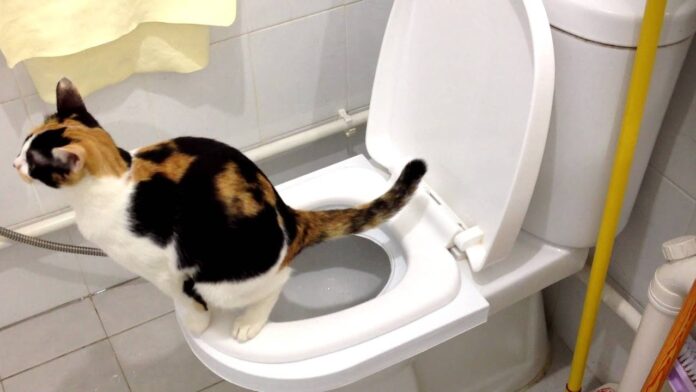Last Updated on September 21, 2023 by Fumipets
Can You Toilet Train a Cat? A Guide to Feline Bathroom Etiquette
Toilet training a cat is indeed possible, but it requires patience, consistency, and a gradual approach. Cats are naturally clean animals, which makes them receptive to this training method. The process involves transitioning your cat from using a litter box to using a toilet.
It’s essential to follow a structured training program, provide the right tools, and be prepared for setbacks along the way. Keep in mind that not all cats will take to toilet training, so it’s crucial to respect your cat’s preferences and comfort throughout the process.
Toilet Training A CAT
It might be a huge, smelly headache to deal with a litter box. It really would be good to have a better option. All of us have sometimes wondered how much simpler our lives would be if our cats would just use the restroom as humans do, especially flushing it after use.
You may have seen kits that assist with toilet training cats. These kits simply involve converting your toilet into a litter box and gradually eliminating pieces of the box until your cat is able to balance on the seat and use the potty. You could have considered how much simpler your life would be if they flushed when they were through, even if they might not. But is this a good idea?
Can Cats Be Toilet Trained?
Almost all cats can be taught to use a toilet. Commercial training kits are available, but if you’re feeling inventive and confident in your abilities to construct something that prevents litter from entering your toilet while you educate your cat, you may DIY a kit.
Nevertheless, some cats may find it challenging to learn how to use the toilet, so think about your cat before you try to educate them using this technique. Although kittens and elderly people may struggle to get on and off the toilet seat without falling in or harming themselves by leaping down, cats with balance issues are likely to find up in the toilet often.
Is Toilet Training Your Cat a Good Idea?
However, teaching your cat to use the toilet is a bad idea. Although your cat using the toilet to relieve itself is handy and far more sanitary in the short term, there are significant issues with cat excrement in the water system.
Pet waste processing is not intended for septic tanks, sewage systems, or water treatment facilities. They are exclusively designed to digest toilet paper and human waste. Cat feces and cat litter that enter the water supply are regarded as pollutants and provide a significant issue. It has been shown that cat feces in the water system degrades the water, which harms natural ecosystems. Fish, amphibians, animals, cattle, plants, and humans might all suffer as a result of this.

What Are the Risks of Cat Waste in the Water?
Cat feces pose a severe harm to the ecology in addition to the other risks mentioned before. The parasite Toxoplasma gondii, which is discharged in cat excrement, may be found in cats. This parasite is zoonotic, which means it may spread from cats to people. Cat feces is the most frequent route for cats to transfer this parasite to people.
Toxoplasmosis is an infection brought on by Toxoplasma gondii. For healthy individuals, this illness often results in headaches, body pains, and fevers that may linger for months, but the symptoms can frequently be controlled with treatment.
Toxoplasmosis may be fatal for persons with weakened immune systems, however. Serious symptoms include disorientation, brain swelling, breathing problems, respiratory infections, vision changes and eye discomfort, seizures, and coma may result from it. It may potentially result in death in extreme circumstances.
Pregnant women are in considerable danger from toxoplasmosis, which may sometimes result in miscarriages and stillbirths.
Shouldn’t Water Processing Plants Filter Out Toxoplasma gondii?
Our water treatment facilities are just not equipped to handle parasites of this kind, particularly in the amount that may develop if a large number of cat owners suddenly began potty training or flushing their cats’ feces.
Contrary to popular belief, toxoplasma gondii is a far more widespread parasite. It is one of the most widespread parasites in the world, and many owners are unaware that their cats are carrying it since cats are often asymptomatic carriers.
The Life Cycle of Toxoplasma
Conclusion
The majority of cats can easily be taught to use a toilet. While it might take weeks to master, the majority of cats are bright enough to figure it out with your assistance. Little and old cats, as well as cats with balance issues, are unlikely to be successful with toilet training without regularly falling into the toilet.
The fact that water treatment systems are not designed to handle animal feces and the parasites linked with it is the main worry when potty training your cat.
Flushing cat feces permits this parasite to enter our water sources, where it may transmit the deadly disease toxoplasmosis to humans and other warm-blooded creatures. Since cat feces may not be effectively processed out of the water, it may potentially have a harmful effect on ecosystems.
Questions & Answers:
Is it really possible to toilet train a cat?
Yes, it’s possible to toilet-train a cat. However, the success of the training depends on the individual cat’s temperament and your commitment to the process.
What are the advantages of toilet training a cat?
Toilet training eliminates the need for a litter box, reducing the associated mess and odor. It’s also more eco-friendly and convenient.
How do I start toilet training my cat?
Begin by gradually moving the litter box closer to the toilet until it’s adjacent to it. Then, gradually raise the litter box until it’s level with the toilet seat.
What if my cat resists the training or has accidents?
Be patient and understanding. Cats may have setbacks or resistance. If accidents occur, don’t punish your cat; instead, adjust the training pace to their comfort level.
Are all cats suitable for toilet training?
No, not all cats will adapt to toilet training. Some may prefer the security of a traditional litter box. It’s essential to respect your cat’s preferences and not force them into a training method that makes them uncomfortable.
Remember, toilet training a cat is a gradual process that requires gentle guidance. It may not be suitable for every cat, but with patience and positive reinforcement, many felines can successfully make the transition from litter box to toilet.


















